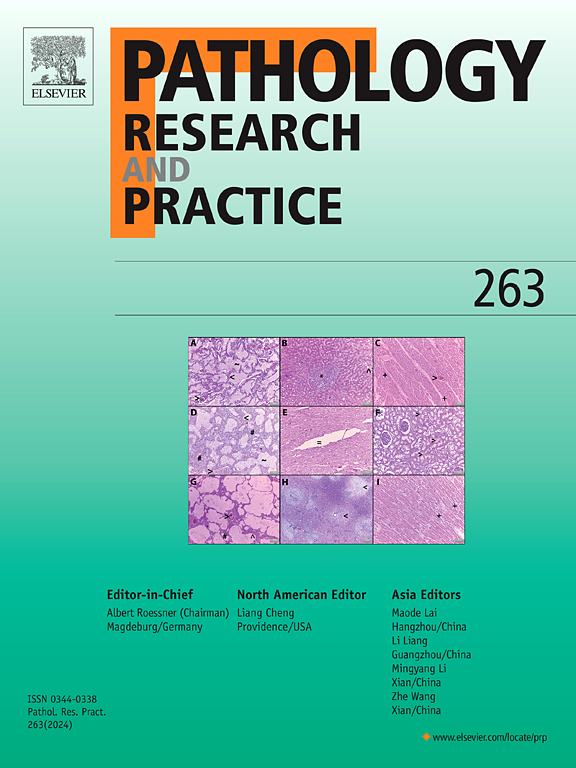Fucoxanthin alleviates secondary brain injury in mice following intracerebral hemorrhage via PI3K-mediated inhibition of NF-κB signaling pathway
IF 2.9
4区 医学
Q2 PATHOLOGY
引用次数: 0
Abstract
Background
ICH is an acute clinical cerebrovascular disease without effective treatments. This study was designed to investigate the therapeutic value of fucoxanthin in ICH treatment.
Methods
Animal ICH models were established by collagenase IV injection. ICH mice were given intraperitoneal injection of fucoxanthin (100 mg/kg). Neurological deficits, brain edema, blood-brain barrier (BBB) integrity, and histological impairment were assessed. Nissl staining and TUNEL staining were performed to detect neuronal cell loss and apoptosis. The levels of tight junction proteins, apoptosis-related proteins, Iba-1, and pathway-related proteins were measured by immunofluorescence staining, western blotting, and ELISA.
Results
Fucoxanthin administration attenuated neurological deficits and brain injuries following ICH. Additionally, fucoxanthin alleviated neuronal apoptosis caused by ICH. Moreover, fucoxanthin inhibited microglia-mediated inflammation and M1 polarization in ICH models. Mechanistically, fucoxanthin inactivated the NF-κB pathway and triggered the activation of PI3K/Akt signaling after ICH, and LY294002 (a PI3K inhibitor) compromised the protective effect of fucoxanthin.
Conclusion
Fucoxanthin alleviates ICH-induced neurological deficits and brain injuries by suppressing the PI3K/Akt-mediated NF-κB pathway to inhibit M1 polarization and attenuate neuroinflammation, neuronal apoptosis, BBB dysfunction, and brain edema.
岩藻黄素通过pi3k介导的抑制NF-κB信号通路减轻小鼠脑出血后继发性脑损伤
背景ICH是临床上一种急性脑血管疾病,目前尚无有效的治疗方法。方法通过胶原酶IV注射建立动物ICH模型。给 ICH 小鼠腹腔注射葫芦黄素(100 毫克/千克)。评估神经功能缺损、脑水肿、血脑屏障(BBB)完整性和组织学损伤。Nissl染色和TUNEL染色用于检测神经细胞损失和凋亡。通过免疫荧光染色、Western印迹和ELISA检测紧密连接蛋白、凋亡相关蛋白、Iba-1和通路相关蛋白的水平。此外,狐黄素还可减轻 ICH 引起的神经细胞凋亡。此外,在 ICH 模型中,葫芦黄素还能抑制小胶质细胞介导的炎症和 M1 极化。从机理上讲,岩藻黄素在 ICH 后使 NF-κB 通路失活,并引发 PI3K/Akt 信号的激活,而 LY294002(一种 PI3K 抑制剂)会削弱岩藻黄素的保护作用。结论福柯黄素通过抑制PI3K/Akt介导的NF-κB通路来抑制M1极化,减轻神经炎症、神经元凋亡、BBB功能障碍和脑水肿,从而缓解ICH引起的神经功能缺损和脑损伤。
本文章由计算机程序翻译,如有差异,请以英文原文为准。
求助全文
约1分钟内获得全文
求助全文
来源期刊
CiteScore
5.00
自引率
3.60%
发文量
405
审稿时长
24 days
期刊介绍:
Pathology, Research and Practice provides accessible coverage of the most recent developments across the entire field of pathology: Reviews focus on recent progress in pathology, while Comments look at interesting current problems and at hypotheses for future developments in pathology. Original Papers present novel findings on all aspects of general, anatomic and molecular pathology. Rapid Communications inform readers on preliminary findings that may be relevant for further studies and need to be communicated quickly. Teaching Cases look at new aspects or special diagnostic problems of diseases and at case reports relevant for the pathologist''s practice.

 求助内容:
求助内容: 应助结果提醒方式:
应助结果提醒方式:


